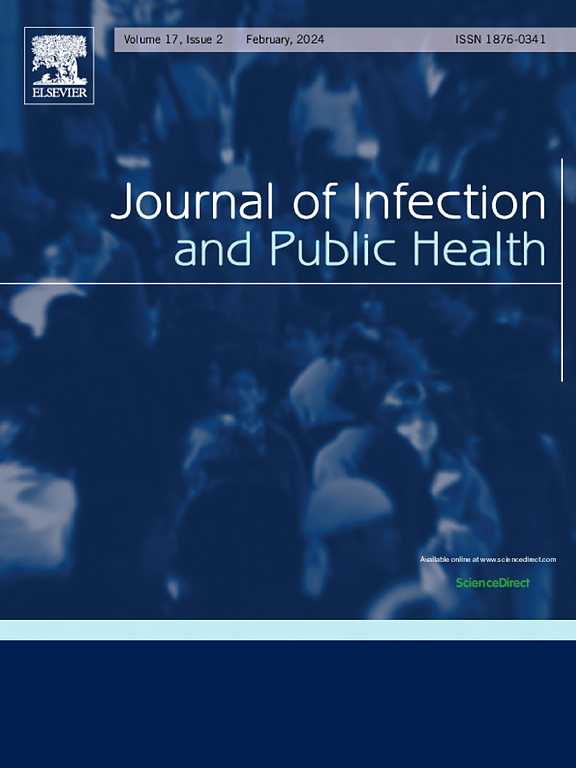2004-2017年威斯康星州综合医疗保健系统中肠道细菌感染的抗菌药物处方实践
IF 4.7
3区 医学
Q1 INFECTIOUS DISEASES
引用次数: 0
摘要
背景:很少有研究评估细菌性肠道感染的抗生素处方做法。不必要的抗生素可导致不良事件并导致抗菌素耐药性的出现。我们在美国威斯康辛州的一个地区医疗保健系统中评估了实验室确诊的肠道感染患者的治疗方法。方法:我们使用电子健康记录对2004-2017年实验室确诊的非伤寒沙门氏菌、志贺氏菌、产志贺毒素的大肠杆菌(STEC)和弯曲杆菌感染患者进行鉴定。提取相关临床数据,包括慢性病的诊断代码和免疫抑制药物和抗生素处方的收据。我们根据病原体、患者特征和研究期间的实践指南确定了适当的治疗方法。结果:我们鉴定出2064例弯曲杆菌感染患者(1251例;沙门氏菌(564;27%),大肠杆菌(199;10%)或志贺氏菌(50%;2%)。总体而言,425例(20%)患者免疫功能低下,从沙门氏菌的17%到产志毒素大肠杆菌的46%不等。有220人(11%)住院。抗生素最常用于弯曲杆菌(53%),其次是志贺氏菌(46%)和沙门氏菌(44%)感染。在处方抗生素中,71%的弯曲杆菌、100%的志贺氏菌和81%的沙门氏菌感染的处方是合适的。尽管建议不使用抗生素,但仍对24%的产志贺毒素大肠杆菌感染开具了抗生素处方。指南的依从性一般随着年龄的增长而下降,除了志贺菌感染,其依从性在≥50岁的成年人中最高。结论:实验室确诊的肠道感染的抗生素处方通常是适当的,但在相当少数的病例中没有遵循实践指南,这是改进的机会。除了其他常见感染外,抗生素管理倡议还应解决急性细菌性胃肠道感染。本文章由计算机程序翻译,如有差异,请以英文原文为准。
Antimicrobial prescribing practices for enteric bacterial infections in an integrated health care system, Wisconsin, 2004–2017
Background
Few studies have evaluated antibiotic prescribing practices for bacterial enteric infections. Unnecessary antibiotics can result in adverse events and contribute to the emergence of antimicrobial resistance. We assessed treatment practices among patients with laboratory-confirmed enteric infections in a regional healthcare system in Wisconsin, USA.
Methods
We used electronic health records to identify patients with laboratory-confirmed nontyphoidal Salmonella, Shigella, Shiga toxin-producing Escherichia coli (STEC), and Campylobacter infections during 2004–2017. Relevant clinical data, including diagnosis codes for chronic conditions and receipt of immunosuppressive medications and antibiotic prescriptions, were extracted. We defined appropriate treatment based on pathogen, patient characteristics, and practice guidelines for the study period.
Results
We identified 2064 patients infected with Campylobacter (1251; 61 %), Salmonella (564; 27 %), STEC (199; 10 %), or Shigella (50; 2 %). Overall, 425 (20 %) patients were immunocompromised, ranging from 17 % with Salmonella to 46 % with STEC. There were 220 (11 %) hospitalizations. Antibiotics were prescribed most frequently for Campylobacter (53 %), followed by Shigella (46 %) and Salmonella (44 %) infections. Among those prescribed antibiotics, prescriptions were appropriate for 71 % of Campylobacter, 100 % of Shigella, and 81 % of Salmonella infections. Antibiotics were prescribed for 24 % of STEC infections, despite recommendations against use. Guideline adherence generally decreased with age, except for Shigella infections, where adherence was highest for adults ≥ 50 years.
Conclusions
Antibiotic prescribing for laboratory-confirmed enteric infections was usually appropriate but did not follow practice guidelines in a substantial minority of cases, presenting opportunity for improvement. Antibiotic stewardship initiatives should address acute bacterial gastrointestinal infections in addition to other common infections.
求助全文
通过发布文献求助,成功后即可免费获取论文全文。
去求助
来源期刊

Journal of Infection and Public Health
PUBLIC, ENVIRONMENTAL & OCCUPATIONAL HEALTH -INFECTIOUS DISEASES
CiteScore
13.10
自引率
1.50%
发文量
203
审稿时长
96 days
期刊介绍:
The Journal of Infection and Public Health, first official journal of the Saudi Arabian Ministry of National Guard Health Affairs, King Saud Bin Abdulaziz University for Health Sciences and the Saudi Association for Public Health, aims to be the foremost scientific, peer-reviewed journal encompassing infection prevention and control, microbiology, infectious diseases, public health and the application of healthcare epidemiology to the evaluation of health outcomes. The point of view of the journal is that infection and public health are closely intertwined and that advances in one area will have positive consequences on the other.
The journal will be useful to all health professionals who are partners in the management of patients with communicable diseases, keeping them up to date. The journal is proud to have an international and diverse editorial board that will assist and facilitate the publication of articles that reflect a global view on infection control and public health, as well as emphasizing our focus on supporting the needs of public health practitioners.
It is our aim to improve healthcare by reducing risk of infection and related adverse outcomes by critical review, selection, and dissemination of new and relevant information in the field of infection control, public health and infectious diseases in all healthcare settings and the community.
 求助内容:
求助内容: 应助结果提醒方式:
应助结果提醒方式:


